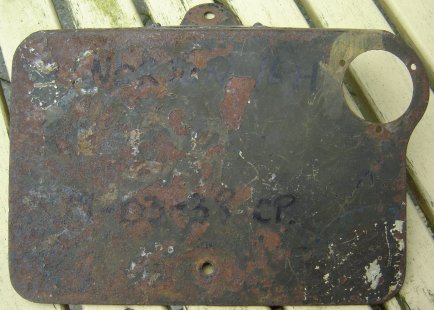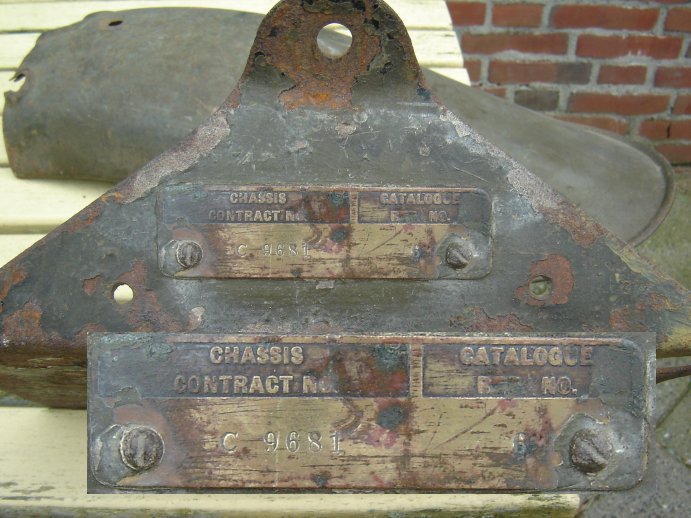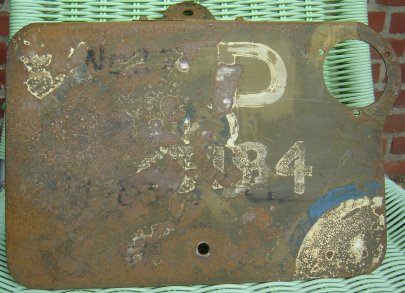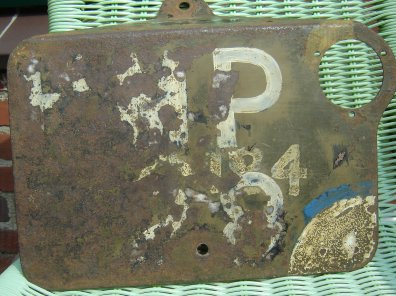|
Another nice find was of an early rear number plate in
spring of 2009 in England. It revealed some nice details after careful
sanding down of the paint applied in several layers.


It was found in half rusted
condition, covered in green paint and still with the contract plate (C9681) fitted
in its original position. By looking obliquely along the plate it was clear
there were other markings underneath the green paint so I decided to sand it
down carefully. This led to a series of discoveries giving a fairly certain
clue to the actual motorcycle to which this plate was attached initially. Pictures
above show where it started and below what the end result was.


The first clue coming to light were blue lined white
semicircles in the upper left and lower right hand corner, and some blue and
white paint in the middle of the plate but without any distinct shape. This
may have been indications for a Royal Signals use of the bike at that
moment.
In the middle, at the right hand side there were also some numbers ending
with 3(?)184 in the typical style as seen on many pre war bikes after the
introduction of the census number to replace the prewar civilian number. As
shown in period pictures these number were handpainted after the initial
gloss black number plates were painted over.
Matching the known census serial numbers for contract C9681 as shown on the
contract plate, this could only have been C383184 indicating to a machine
being given its census number in 1938 and thus being late in the contract
(91st before the end counting the total census numbers) of
which the first bikes were manufactured in May 1937 and the last on May 15th
1938. Going back for 91 bikes from the latest bike built, the production of the bike connected with this
numberplate will have been around beginning
of March 1938. (The hand written marker information was therefore very
close!). Unfortunately, matching prewar census numbers to prewar
frames is basically impossible. Norton machines were then not
manufactured in an orderly consecutive numbering fashion when looking at frame numbers.
Added to that is that it is unknown what the military exactly did when applying the
census numbers. The bikes were most likely given a number in batches as they
left the factory/received by the military and its expected that the miltary
did not wait until they had the next
consequetive frame number.
Sanding further, the final clue came through. First
a clear P, then an 8 and further the remains of what have been an M and a 2
when guestimating using a clear example from a Pathé still supplied by
Richard Payne. When finally finished, I am rather certain that the number
has actually been HMP 328 ! being in the same Middlesex registration
range as shown in the Pathé still!!!
The 3 on the numberplate is the least certain number, but looking at the plate obliquely again
from various angles there is an indication in the "rust" pattern which makes
it rather likely a 3.
There is not much doubt that these paintings are still
the original from the pre war period. The rear number plates were basically
discarded after 1940 and nobody had interest in using it anymore. Its
also different from the 1938 numberplate as that has a 2 bolt top fixing to
the rear mudguard portion where this one only has one bolt top fixing and
would therefore not have fitted on any bike made after this contact was
finished.
Finds like these are very valuable to reconstruct the
history of the Military 16H/Big4 machines. Together with the petrol tank
found in near original state it gives a good indication of the application of
census numbers in the prewar period.
|

